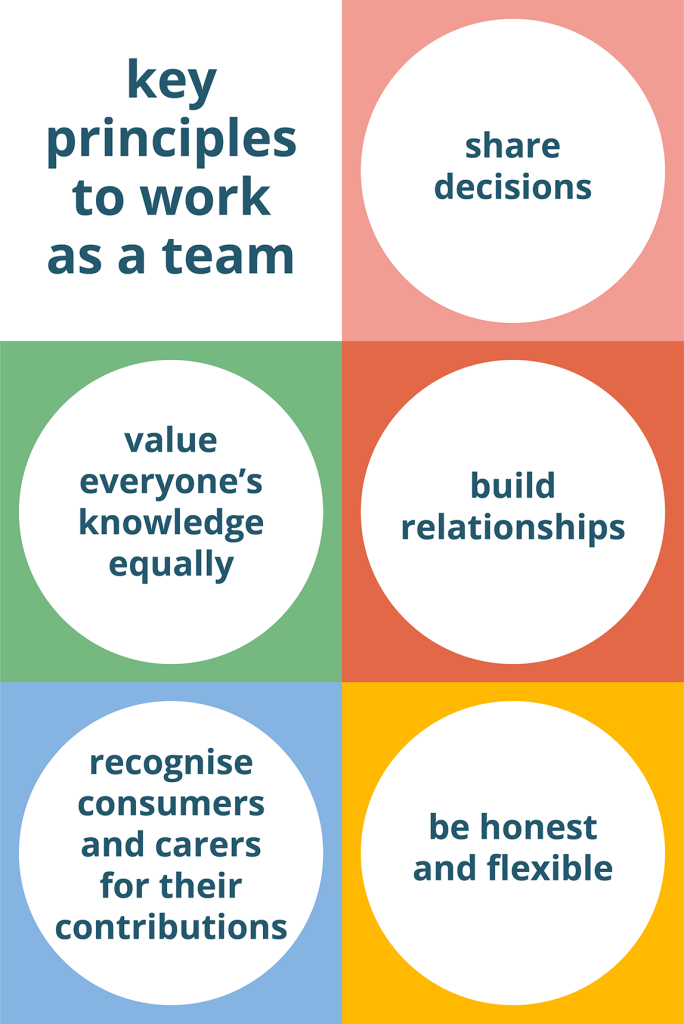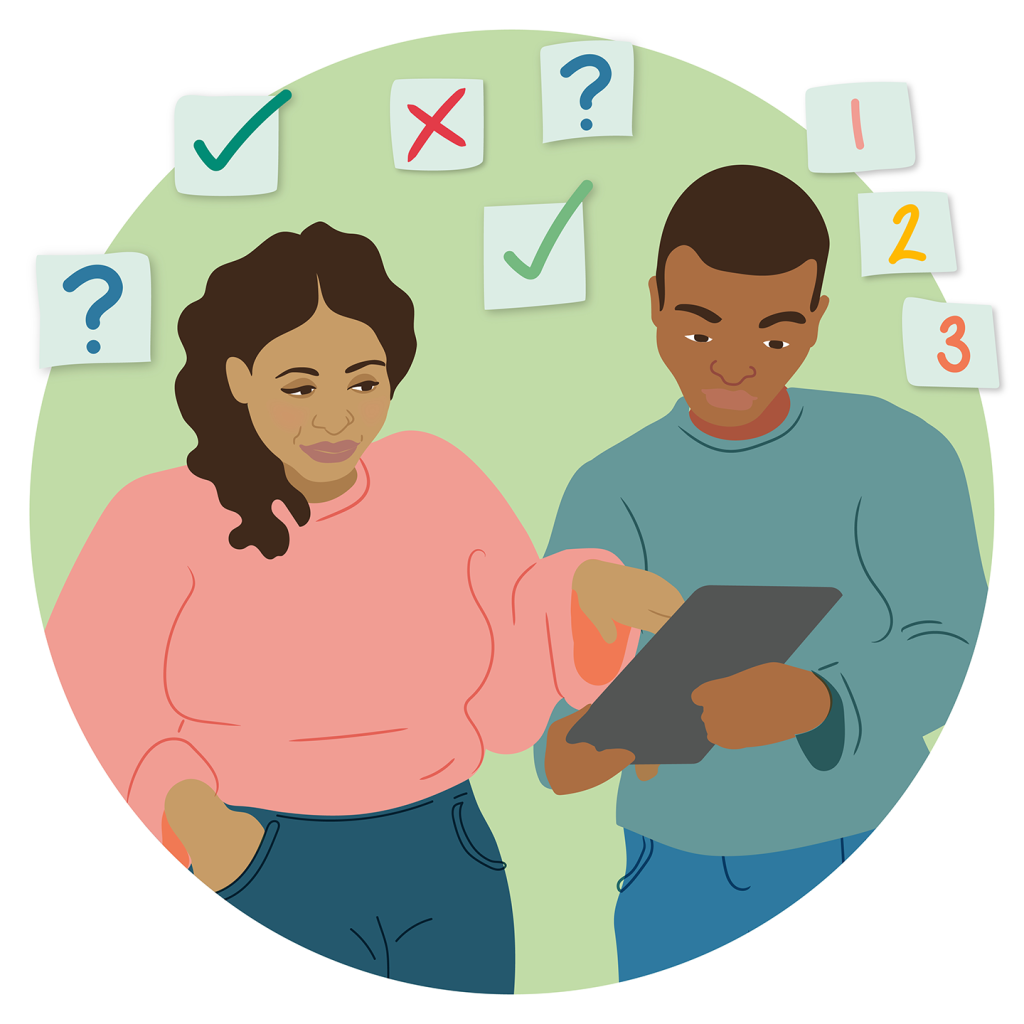- Home
- before you begin your research
before you begin your research
Research starts with relationships. Relationships and trust take time. When we rush to start, we often miss important conversations with the people we want to work with. Rushing can create problems later and can slow or stop the research.
Our design process identified five principles that build on NSW Health’s All of Us Guide [1] and other resources [3,4,5,6,7,8] to help researchers, consumers, carers and health workers co-design and co-deliver research.
Read more on each principle here.
- Share decisions
- Value everyone’s knowledge equally
- Build relationships
- Recognise consumers and carers for their contributions
- Be honest and flexible
download key principles poster [PDF]
A note on the key principles. We acknowledge many knowledge and value systems, especially those of Aboriginal and Torres Strait Islander peoples. We recommend the key principles as a guide for research co-design and co-delivery, not as a rigid set of rules or as a replacement for communities’ own language, world views, values or protocols.
You might think and talk about:
- What do the principles mean to me / us?
- What do the principles mean to the people I am / we are working with? What words and concepts do they use?
- What am I / are we doing well from the principles already? What’s getting in the way?
- What practices, protocols and tools could help turn words into actions? See our example [PDF]
- How might we use the principles at the start? Throughout the research?
- How will we be accountable to using the principles?
- What do I/we need to learn? Un-learn?
We sometimes make assumptions about each other, our role and about the best way to do research. When working in partnership, recognising, sharing and questioning our assumptions improves teamwork. So, here are some questions to help researchers to co-design and co-deliver research.
Download a copy of the questions [PDF]
The questions build on existing resources [1,2,3,5] and from conversations with consumers and researchers. The questions sit alongside the National Statement for Ethical Conduct in Human Research.
assess the fit
- What’s our understanding of co-design and co-delivery in research?
- How much co-design is possible? Read: Shades of Co-design [9]
- Can we commit to making decisions together with people with lived experience, every step of the way?
- Is the research suited to co-design and co-delivery with people with lived experience, health workers and others?
- Does the research need a culturally specific or community-specific approach? [e.g. 10,11,12,13]
- Have people with lived experience previously been harmed or let down by research? If there has been harm or let-downs, how will we change our approach?
- What else is happening for consumers, carers and communities right now?
- Am I / are we the right people to be leading this work?
- How could the power differences between me/us and community members impact the work?
explore your resources, intentions and constraints
- What time and budget do we have to involve consumers and carers from start to end?
- What rules from our institution and/or the grant exist that will shape how we work as a team? Are there limits on how we can recognise consumers’ and carers’ time and contributions?
- Am I / are we open to different perspectives and changing how we work? (e.g. our approach, priorities, meetings, processes, the activities we want to do)
- How will we involve consumers and carers from the beginning, in priority setting and planning the project?
- Am I / are we seeing consumers and carers as participants, as colleagues and partners or something else?
- What discussions have we had about each other’s roles, skills and interests? (consumers and carers included)
- What do consumers and carers say they need to be part of the team?
- How will we check-in with each other and come back to the key principles?
Here are some questions for consumers, carers and communities to decide if and how they want to take part.
Download a copy of the questions [PDF]
The questions build on existing resources [1,2,3,7] and from conversations with consumers and researchers. The questions sit alongside the National Statement for Ethical Conduct in Human Research.
You don’t have to answer all the questions.
about the purpose of the research
- Why do researchers want to involve people with lived experience?
- Is the research needed? Could the research benefit me/us? Could it harm me/us?
- What does co-design and co-delivery in research mean to me?
- How much co-design will be happening? Read: Shades of Co-design [9]
- What decisions have been made already (on research priorities, timeframes, roles in the research team or something else)? Am I okay with what’s already been decided?
about your role
- Am I ready to use my lived experience in research?
- What roles are available for me in the research? (e.g. being on a committee, being a Chief Investigator, Co-investigator, Peer Researcher or something else)
- Am I being asked to give advice, be part of the team or something else?
- Is my role clear?
- Are other consumers and carers part of the team? Will I be the only one?
about your time
- Do I have time?
- What role would best fit in my life right now?
- What will I get out of this? (helping my community, learning, getting research experience, getting remuneration, something else)
- Does the recognition on offer seem fair?
about the support available
- What will I need to be part of the team and to do the work?
- What support is available? (e.g. technology and tech support, travel, transport, translators, interpreters, childcare, peer support, training, mentoring, supervision)
- Can I ask for flexibility? (meetings outside standard work hours, longer to do tasks, a buddy or something else)
- Will my knowledge, identity, culture, access needs and strengths be understood and respected?
make decisions about your involvement
- What is my gut feeling?
- Do I have enough information to decide?
- What questions do I want to ask to decide what’s right for me?
Funders and organisations have an important role in creating the conditions for researchers, health workers, consumers and carers to work together – for example, by making sure there are resources and accountability for co-designing and co-delivery research.
Here are some questions for funders and organisation leaders:
- How will our rules and requirements impact researchers’, consumers’, carers’ and health workers’ ability to work together from start to finish?
- How can we make it easier for consumers and carers to be part of research teams?
- What is our understanding of co-planning, co-designing, co-producing and co-evaluating research? How have we communicated that?
- How will the people we employ/fund be supported and accountable for involving consumers, carers and communities in respectful, inclusive and meaningful ways?
- How are we investing in the skills and leadership development of consumer and carer researchers? (Consumer and carer researchers are also often called ‘lived experience researchers’.)
- Are we making space for community/culturally specific projects and design practices, for Aboriginal ways of knowing, being and doing?
- How will we carry the values of co-design into project monitoring and evaluation? (e.g. through using co-evaluation, by hearing directly from the communities involved)
Alongside the key principles, here are some structures and habits that existing resources [1,2,4,5] and consumers, carers and researchers told us support success throughout:
- Aim to identify and budget for lived experience roles at every level of the project, from project governance through to the research team and across each research phase.
- Take time for relationships. Co-decide how you’ll check-in with each other as a team and one-to-one. Decide how you’ll come back to the key principles. Schedule team meetings and stick to them. Don’t wait for the evaluation at the end of the project to raise or talk about what isn’t working so well, or what might need fixing.
- Run meetings and workshops with care and hospitality so everyone involved can participate. Be flexible with meeting times (including out of standard work hours), places (away from clinical places) and formats. Give choices. Ensure accessibility and welcome.
- Ensure a diversity of experiences and identities in your research team. Focus on creating and maintaining safety and ensuring inclusion, as well as diversity.
- Notice the emotional impacts of the work on the team and on people with lived experience. Prioritise care and open conversations. Check-in with each other, make space for positive impacts as well as grief and frustration. Practice collective care and make it okay for people with lived experience to step back when they need to.
- Value lived experience/expertise equally to clinical and academic experience. Use power in partnership.
- Understand that consumers and carers usually don’t have access to the same resources as conventional researchers. Consider resources to share with consumers and carers to support their involvement (e.g. relationships, learning, technology, travel).
- Make peer support available for everyone involved.
- Be willing to change processes and ways of working.
Agency for Clinical Innovation – individual reflection on meeting co-design capabilities [PDF]
Auckland Co-design Lab – framing and enabling participation guide [PDF]
Health translation SA – embedding community and consumer engagement in grant applications [PDF]
[1] New South Wales Government, Ministry of Health. (2023). All of Us: Six ways of working. Retrieved from https://www.health.nsw.gov.au/patients/experience/all-of-us/Pages/six-ways-of-working.aspx
[2] NSW Agency for Clinical Innovation. (n.d.). Co-design Toolkit. Retrieved from https://aci.health.nsw.gov.au/projects/co-design
[3] Bellingham, B., Elder, E., Foxlewin, B., Gale, N., Rose, G., Sam, K., Thorburn, K., River, J. (2023). Co-design Kickstarter. Community Mental Health Drug and Alcohol Research Network, Sydney.
[4] Medical Research Future Fund. (2023). Principles for Consumer Involvement in Research Funded by the Medical Research Future Fund.
[5] McKercher, K.A. (2020). Beyond Sticky Notes. Doing co-design for Real: Mindsets, Methods, and Movements, 1st edn.
[6] International Association of Public Participation [IAP2]. (2007). IAP2 Spectrum of Public Participation.
[7] Western Australian Health Translation Network. (2021). Involving Consumers in Health and Medical Research: A practical handbook for organisations, researchers, consumers and funders. Retrieved from https://wahtn.org/wp-content/uploads/2021/09/WAHTN-CCI-Handbook_29092021.pdf
[8] Lamb, K., Dembele, L., Nina, F., Hegarty, K. (2023). An Australian Framework for the
ethical co-production of research and evaluation with victim survivors of domestic, family, and sexual violence. University of Melbourne: Australia.
[9] Blomkamp, E. (2024). Shades of Co-Design. Retrieved from https://emmablomkamp.com/blog/shades-of-co-design
[10] National Health and Medical Research Council. (2008). Keeping research on track II: A companion document to ethical conduct in research with Aboriginal and Torres Strait Islander Peoples and communities: Guidelines for researchers and stakeholders.
[11] Sharmil, H., Kelly, J., Bowden, M., Galletly, C., Cairney, I., Wilson, C., Hahn, L., Liu, D., Elliot, P., Else, J., Warrior, T., Wanganeen, T., Taylor, R., Wanganeen, F., Madrid, J., Warner, L., Brown, M., de Crespigny, C. (2021). Participatory Action Research-Dadirri-Ganma, using Yarning: Methodology co-design with Aboriginal community members. Int J Equity Health. 2021 Jul 12;20(1):160. doi: 10.1186/s12939-021-01493-4. PMID: 34247644; PMCID: PMC8274049.
[12] TransHub. (n.d.). Researchers as allies. Retrieved from https://www.transhub.org.au/allies/researchers
[13] Intersex Human Rights Australia. (2012). Researching intersex populations. Retrieved from https://ihra.org.au/research/
go back – from start to end
go to the next section – decide what to research

